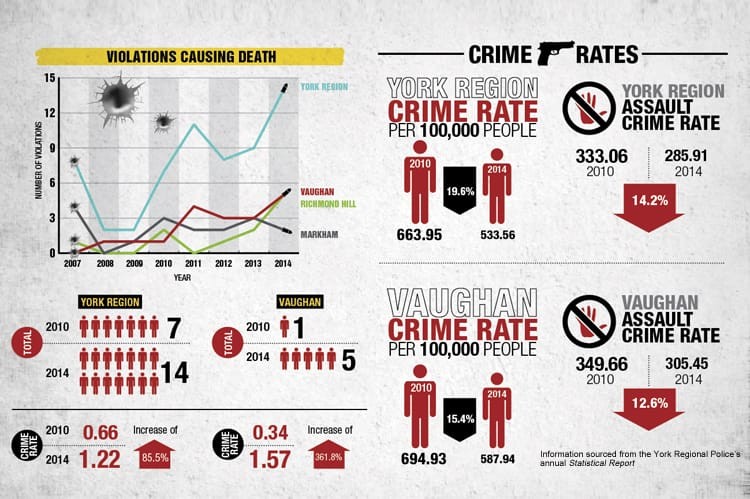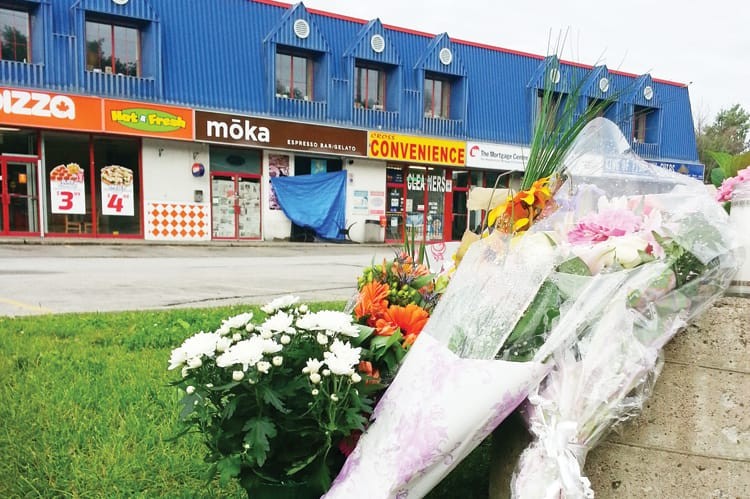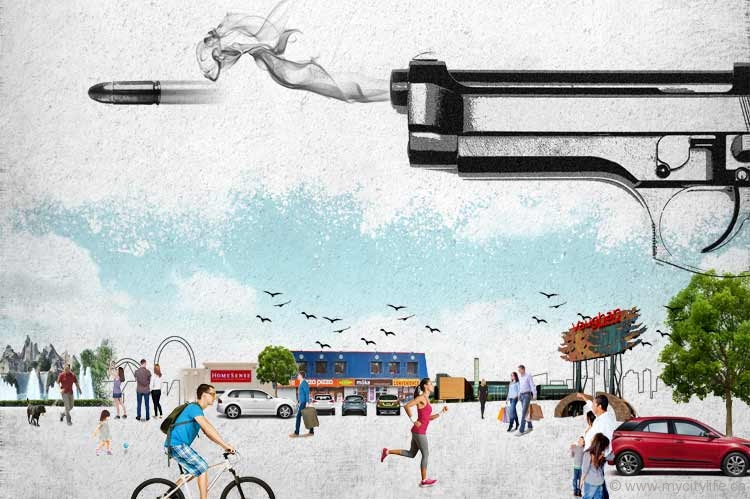Under The Gun
UPDATE:
York Regional Police have released the name of the Moka shooter and issued a warrant for his arrest. The suspect has been identified as Jason Hay, a 27-year-old Mississauga man. He is considered armed and dangerous.
York Region has been considered one of the safest communities in Canada for years, and Vaughan one of its safest cities. And yet, periodic bursts of targeted gun violence, often linked to criminal activity, have tainted the pristine image of a city on the rise. In the wake of the Moka café shooting, the most recent daytime attack that’s left two Vaughan citizens dead, City Life Magazine asks: Why is this happening? And what’s being done to combat it?
The black hatchback came to a stop out front of Moka Espresso Bar & Gelato at an angle that ignored the white parking lines, positioned for a swift exit. It was a clear June morning and the sun had just climbed above the towering trees that overhung the lofty concrete retaining wall across the street from the modest strip mall on Islington Avenue south of Highway 7, casting a long shadow from the feet of the hooded figure that emerged from the vehicle. The man stood about six feet in height with a burly frame, his face hidden by a light-grey hood and a black mask pulled up and over his mouth. When he entered the café, he did so with cold-blooded intent.
At 8:18 a.m., a time when most are heading to work, taking kids to camp or grabbing a quick breakfast, York Regional Police responded to a 911 call from inside Moka. The perpetrator had pulled out a gun and opened fire on the early-morning patrons and staff. When officers arrived, “they found quite a scene,” Const. Andy Pattenden later explained to the scrum of media gathered behind the fluttering black-and-yellow police tape lining the strip mall’s parking lot. Long gone was the vehicle, a 2011 Nissan Versa, which police later learned was stolen from the Greater Napanee area, and four people had been shot, two of them fatally. Former Toronto mayoral candidate Rocco Di Paola was one of the injured victims. Among the deceased were Moka employee Maria Voci, 47, a mother of three, and café regular Christopher de Simone, 24, both Vaughan citizens.
The following day, on June 25, a backlog of traffic built up north and south along Islington as police stopped cars travelling by the strip mall. They asked if the commuters knew anything about what had transpired the day before, if they recognized the suspect or the vehicle in the photo they handed through driver-side windows. Afterward Const. Pattenden would tell reporters that, after reviewing security camera footage, investigators “could definitely tell that the suspect entered the café with a purpose.”
The tragic shooting at Moka has once again sent ripples through a community that’s becoming all too familiar with open displays of premeditated violence. The Moka incident marks the fourth shooting in the area in 15 months, and comes in the wake of the bloodiest period that Vaughan has seen in a decade, where a string of targeted shootings left six dead.
It started with the shooting of suspected mafia hitman Salvatore Calautti, 41, and his associate James Tusek, 35, when the pair left a bachelor party at Terrace Banquet Centre in the early morning of July 12, 2013. Nine months later, on April 24, 2014, GTA mobster Carmine Verduci, 56, was shot dead in broad daylight outside the Regina Sports Café in the Highway 7 and Martin Grove Road area in Woodbridge. Two weeks after, on May 4, Ritesh Thakur was gunned down in front of shoppers outside the HomeSense at the RioCan Colossus Centre near highways 400 and 407; the 41-year-old Indian man had been previously charged in a $6.5-million drug bust. The following month, on June 6, a double shooting at Baggio’s Café on Woodstream Boulevard left Sarhad Sadiq, a 36-year-old Assyrian man who was also involved in a multi-million-dollar drug bust in 2006, dead and one other injured; Sadiq’s murder marked the fifth in Vaughan in less than a year. And near the end of September, on Wednesday the 24, Ajax man Gul Mohammed Alakoozi, 32, was killed and another man injured in a second double shooting on Via Borghese Street, a quiet residential area by Major Mackenzie Drive and Weston Road.
By summer 2014, the words “brazen” and “shooting” had become common among newspaper headlines in the city and around the GTA. Many if not all of these shootings showed signs of connection to organized crime and, while terrifying when considering the bold and highly public nature of the attacks, were also targeted killings considered to be isolated incidents. With the equally as brazen Moka incident, this trend of sporadic gun violence has been ushered into 2015, leaving eight people dead over two years and a community speculating as to who’s behind it and why it’s happening in a city known to be one of the safest in Canada.
As it stands, police are still unclear as to the Moka shooter’s motivation. “We don’t know motive. We don’t know who was the intended target in this case,” says Const. Laura Nicolle, a spokesperson for the YRP, when asked about possible reasoning behind the Moka shooting. Police won’t speculate on the matter, either. But the Moka shooting does have a different feel than past shootings and, as Nicolle adds, doesn’t seem to “fit the pattern.”
Indeed, last year’s shootings showed a clear indication as to who the targets were — the executed individuals were the sole focus of whatever rage or vengeance or display of power motivated the assassin and his employer. But what transpired at Moka appears to lack such cold, surgical precision. With two wounded and two dead, all having no obvious connection to each other outside of the café, the Moka shooting has all the qualities of arbitrary brutality, of desired attention, of a resounding exhibition of dominance. And that’s perhaps what’s most frightening about the Moka shooting: the seemingly senseless, indiscriminate and intentionally conspicuous violence of it all.
Residents along Pioneer Lane, the quiet neighbourhood across the street from the crime scene, offer mixed reactions to the shooting. Many simply don’t want to talk, some because you’re the media, others because they’ve said their piece to police. Those that do will tell you that, yes, it’s tragic and a little unnerving, but they feel the community is still a safe one — and besides: What are people to do? Never leave the house?
“It’s a shame,” says one man, who asked not to be named, of the shooting. He frequents the variety store next door to Moka and would see some of the victims from time to time. It’s hard to stomach, seeing as he has children and it’s so close to home. But he still feels the neighbourhood isn’t a dangerous one. “I think these are isolated incidents,” he says. “I still consider it a safe area.”
An elderly gentleman in the neighbourhood, who also asked not to be identified, felt the shooting was “intimidating,” but feels the answer isn’t to remain locked up in your home. As an immigrant himself, he understands how bad things can be in other countries. “We are lucky to have this type of police force,” he explains. “When you want to learn about what you have here, you go somewhere else. When you come back, you’ll kiss the ground.” But he’s also conscious of this violent problem and concerned about the ominous possibilities it presents. “We’re moving to the negative side, little by little,” he adds. “And nobody wants to say that, but that’s happening. It’s happening here.”
It’s certainly understandable why citizens may feel apprehensive under the cloud of these shootings, as periodic as they may be. But do the numbers support such views?
According to the YRP’s Statistical Report for 2014, over the past five years York Region has seen a noticeable drop in crime all around. Crime rates for sexual violations, assault and robbery have all dropped and the overall rate for crimes against persons has steadily declined from 2010 to 2014 by nearly 20 per cent.
In Vaughan, this trend is largely the same. The rate for total crimes against persons has declined by 15.4 per cent over the past half a decade, and what’s more, the crime rate in the city has been reduced by an impressive 27.4 per cent over the past decade. These numbers have consistently rated Vaughan, and York Region as a whole, as one of the safest communities in the country. (See infographic for more in-depth statistics.)
But while crime in general is on the decline, these shootings have been part of an upward trend of what the YRP describes as “Violations Causing Death.” VCDs include all homicides, such as first-degree murder, second-degree murder and manslaughter, and criminal negligence causing death. From 2007 to 2010, Vaughan averaged less than one VCD per year — meaning less than one homicide per year — with a rate that peaked at 0.37 per 100,000 people in 2008.
But since 2011, Vaughan has had no less than three VCDs each year, with four in 2011, three in 2012, three in 2013 and five in 2014. Those five homicides in 2014 — the four shootings plus a double stabbing at Canada’s Wonderland in October that left one dead — proved to be the most in the city since 2003. In fact, in the past four years, from 2011 to 2014, Vaughan has experienced a total of 15 VCDs — two more than the 13 from the previous seven years combined.
Which is what makes these recent shootings so puzzling and unnerving. In a city where crime overall seems to be on the decline, why are citizens seeing such open displays of fatal, purposeful violence?
A possible reason may have been uncovered in the aftermath of the Moka shooting. About two weeks after the investigation began, police released information that evidence of a “gaming operation” had been found at the café — things such as cards, card tables and electronic gaming machines. Const. Nicolle explains that police are not calling it gambling, as that would require evidence of the exchange of money. They’re also not speculating as to whether this links the shooting to criminal activity, despite obvious assumptions as to what these items mean. “We’re not speculating or going down that road right now, but obviously our investigators are going to look at every possibility,” she says.
But some reports have suggested that the café has a history of ties to criminal activity. One newspaper article noted that Doppio Espresso Bar, the business that occupied the space before Moka opened in March of this year, was known to be a place where organized crime members regularly congregated. Even Carmine Verduci, the now deceased heavyweight in the Toronto mafia, was said to periodically appear at the former café. The police, however, have not confirmed whether organized crime members have ever met in the building.
For organized crime expert Antonio Nicaso, author of 28 books on the subject, finding evidence of a gaming operation at the crime scene shouldn’t seem out of the ordinary. “York Region,” he says, “is traditionally known in the underworld for money laundering operations and gambling.” Nicaso explains that gambling is a major issue because of its profitability and lowered risk for criminals. Other illegal activities such as drug manufacturing, smuggling and selling have huge risks and involve much manpower to move and distribute product. But a gambling operation may only require a single individual recording numbers on a piece of paper. Debts can be collected afterward, making it difficult to detect. “Sometimes it’s a problem that’s underestimated,” Nicaso says, “but it’s a phenomenon that generates a lot of money.”
While Nicaso acknowledges that the reason for the shooting is still unclear, he gives several reasons for its possibility — if, that is, the incident indeed has ties to criminal organizations. One possibility is that there is infighting within a criminal group in the area, perhaps a play at the “forced acquisition” of bars and cafés that are used for gambling. Nicaso explains that in York Region the big name in terms of organized crime is the ’Ndrangheta, a Calabria-based syndicate of mafia families, but there are also emerging groups, such as the Albanians and Russians. Maybe even new players are trying to muscle for their spot at the table, given how the Moka shooting is quite different from traditional mob hits.
“Usually hired killers tend to choose their targets carefully rather than openly fire in busy spots,” Nicaso says. “It seems like the killer was not a professional one and seems that he shot randomly, and most likely the two victims were not the targets of his actions.”
The shooter, he adds, was possibly trying to send a message. But to whom? One of the victims or someone else inside? The café? Another party? “That’s the big question,” Nicaso says.
Despite the conspicuous nature of these shootings, Nicaso doesn’t believe that citizens should panic. York Region, he says, is still a safe place to live and work, as the criminal organizations here will likely want to keep their interests secure. “It’s the place where they invest the money,” he says. “So traditionally you keep safe the place where you invest the money.” Adding: “I don’t think there is an interest to ruin the balance.”
But Nicaso also believes gambling shouldn’t be just a law enforcement issue. It should be a political one. “I think everybody should be looking into fighting this problem in the proper way, not underestimating the consequences and effects of illegal gambling,” he says.
In an email interview, Vaughan Mayor Maurizio Bevilacqua explains that the city works closely with the YRP on a number of safety initiatives and that he has “complete confidence” in Police Chief Eric Jolliffe and his team. Safety, he adds, is a top priority for city council, as it’s one residents expect in a growing city.
“We understand the public’s concern over the shootings, but we should not be living in fear,” he says. “The City of Vaughan has consistently ranked among the highest municipalities in all of Canada when it comes to safety. These tragic incidents appear to be isolated and not intended for the wider community.”
On the police front, Const. Nicolle explains that there are a number of initiatives underway to combat criminal organizations. For the sake of security and strategy, however, she can’t reveal specifics. But she points to the recent success of Project OPHOENIX, an initiative by the Combined Forces Special Enforcement Unit (CFSEU), where 19 arrests of ’Ndrangheta members were made. This joint-forces investigation, which involved elements of the RCMP as well as Toronto, York, Durham, Peel and Ontario Provincial Police, began in May 2013 and involved drug importation and trafficking, firearms trafficking, extortion, laundering and more. Arrests were made all over the GTA in early June and included three Vaughan men.
In a released statement, Supt. Keith Finn, the officer in charge of the GTA CFSEU, says, “The presence of such organized crime groups brings an element of criminality to our communities that is unacceptable,” and that all the CFSEU members “are committed to ensuring people committing these crimes are held responsible.”
For the rest of citizens here in Vaughan there’s not much else to do aside from bringing any pertinent information to police. At the time of writing the Moka investigation is still ongoing and the shooter, described by police as a six-foot black male with a muscular build, is still at large. The YRP has released a clear image of the suspect where he’s surveying Moka the day before the shooting, giving hope that exposing his face will help bring him to justice. His motivation, however, remains unknown, shrouding any answers in mystery, rumour and speculation. Who was the target of the attack? In what order were the victims shot? Why were two left alive while two were killed? Police don’t have an answer, and if they do they aren’t releasing it. The city is left with questions.
About a week after the shooting, it seems the city is back to its usual hum. People have returned to the strip mall — some drift in and out of the convenience store next door to Moka, others enter and exit the real estate office three doors down. An employee at Cross Convenience, the adjacent convenience store to Moka, explains that an individual working on the day of the shooting quit, but won’t say anything more. The only signs of that violent morning are the newspapers and blue tarp covering Moka’s windows and a small memorial of flowers laid by the roadside. Business, it seems, has returned to normal.
And why wouldn’t it? As the numbers show, the city, overall, is a safe one. The crime rate for homicides in Vaughan was only at 1.57 per 100,000 people in 2014 despite the shootings. And eight murders over two years, while brazen and unsettling and tragic as they have been, are not uncommon for larger cities. Mississauga had eight homicides in 2011 and seven in 2012. Last year Brampton too experienced seven, and even Richmond Hill, which aside from King had the highest average home prices in York Region last year, had five homicides in 2014.
But that doesn’t mean these acts should be ignored or accepted as the norm. The possibility of something can be less than one in a million, but none of that matters when it actually hits home, when it’s your family that’s robbed of a loved one. The shootings of the past two years don’t appear to be crimes of passion or spur-of-the-moment incidents. They have planning and purpose and meaning, and a root that can be addressed.
Concerns will linger while this type of gun violence persists, and questions will always remain. Questions like: Will the city see more bloodshed in the future? Or will the work by police or the desire to maintain balance, as Nicaso noted, restrain that form of violence? Only time will give answers. Until then, the city will carry on, as it must, with the possibilities of the past ever present, like long shadows cast from our feet on a sunny June morning.



















































































No Comment